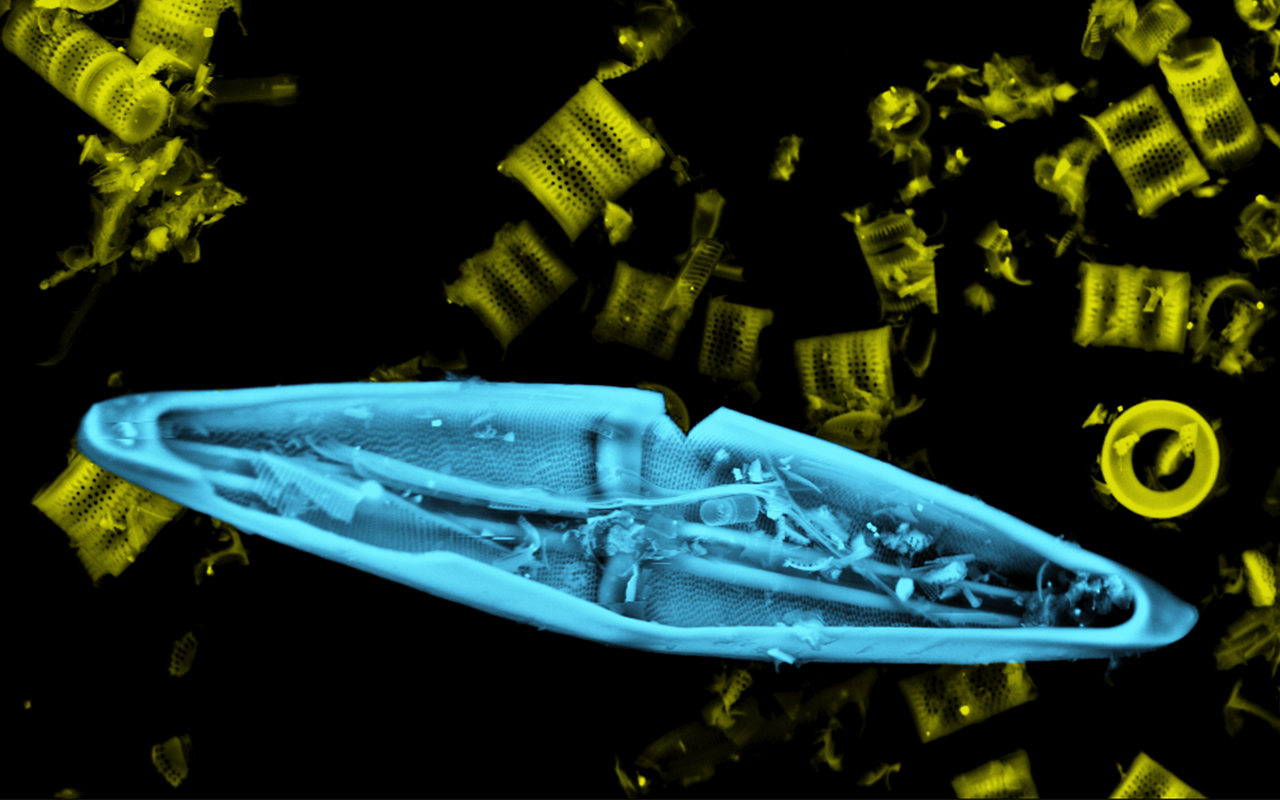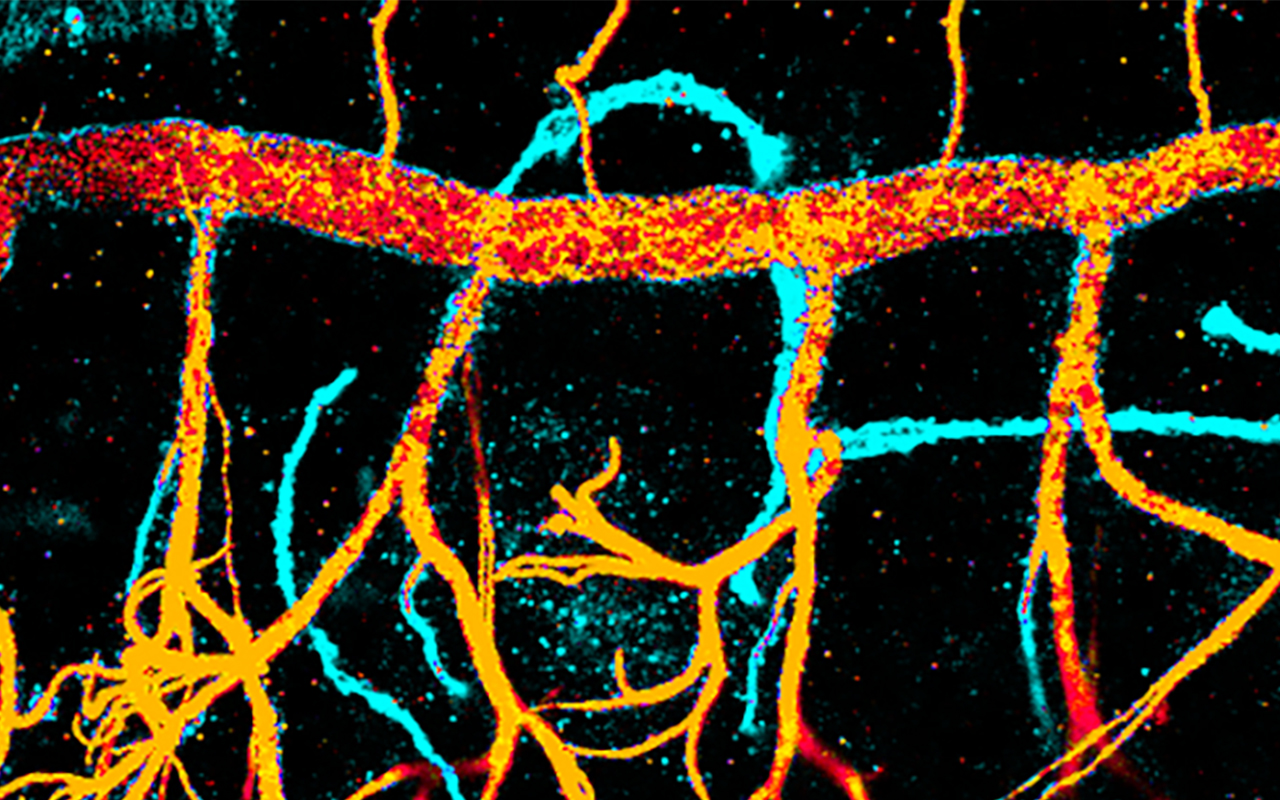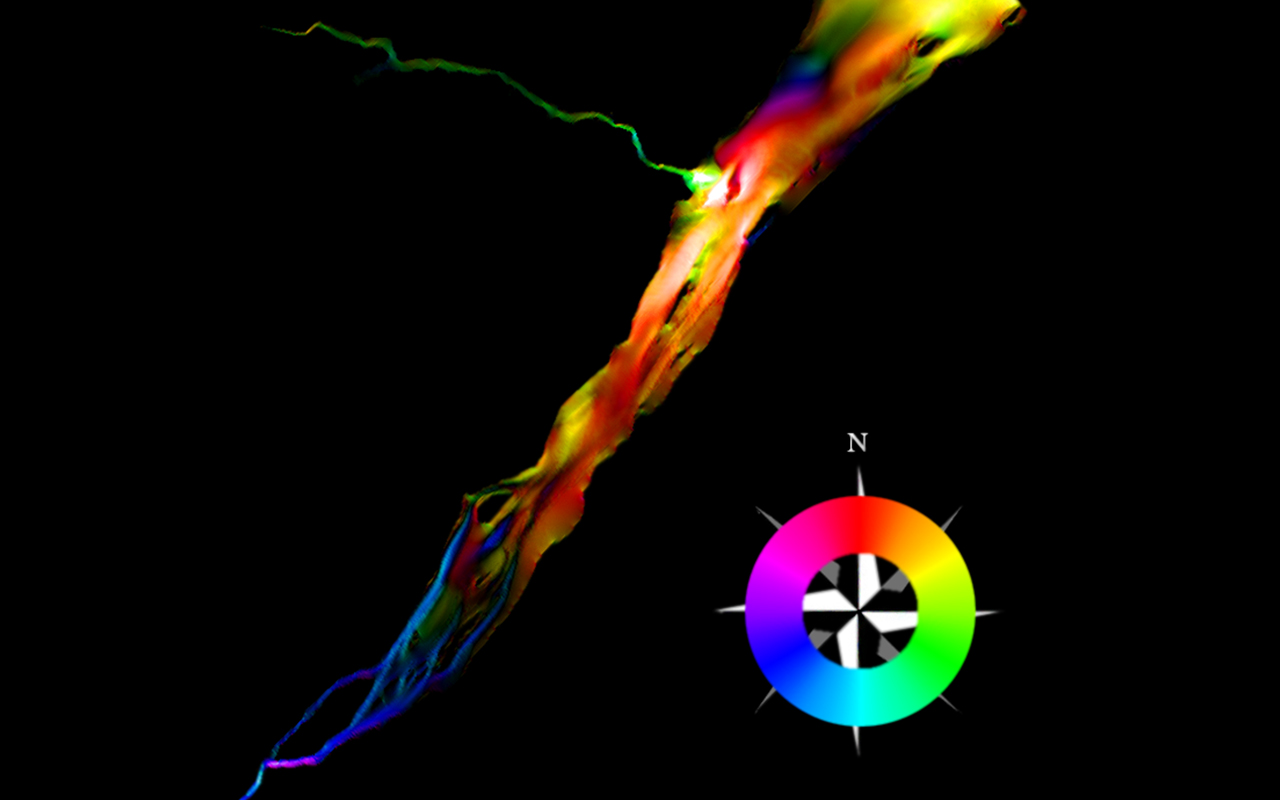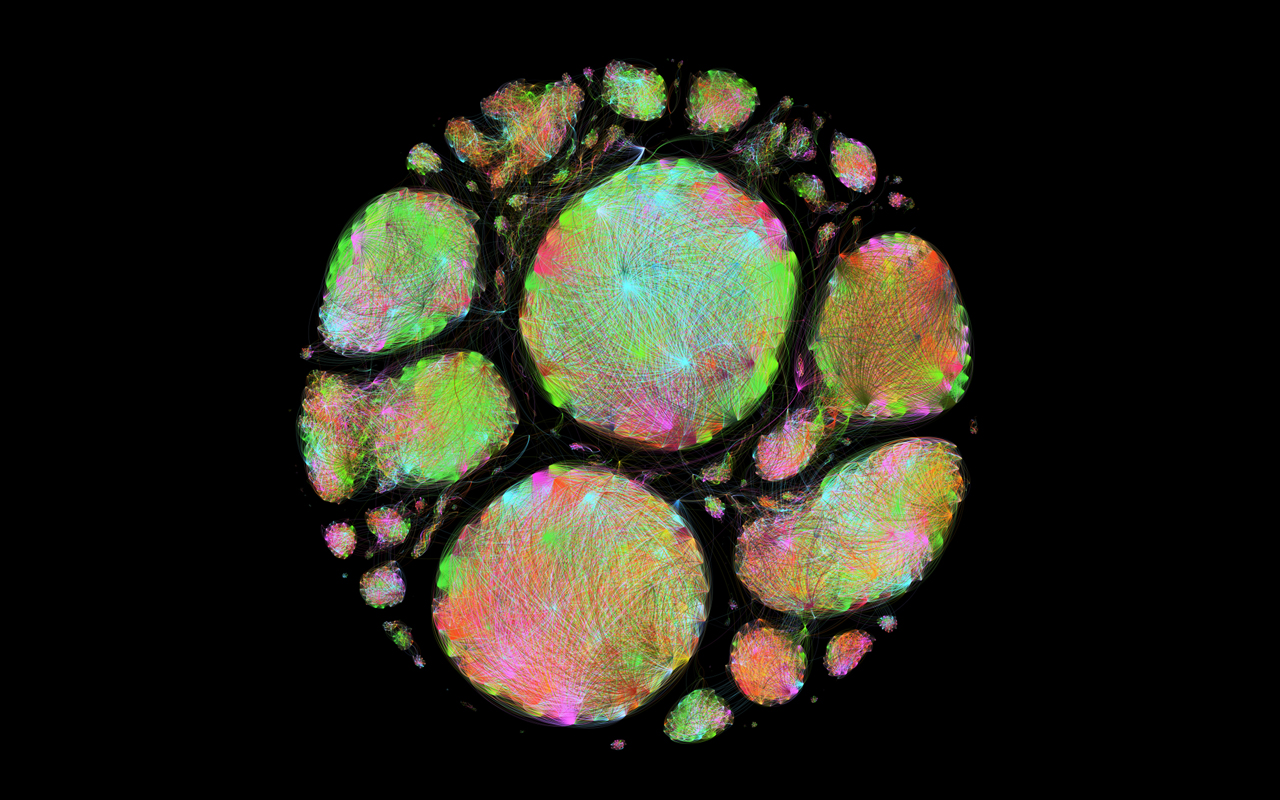

Photo by Ehsan Rezabeigi
Rebuilding damaged bones
Using metallic implants to replace a piece of bone damaged by disease or an accident can lead to serious complications, including infection and rejection by the body. A Concordia University postdoctoral fellow is working on a better way, using a lightweight implant made of glass and polymer foam that promotes bone regrowth and healing. These flower-like structures, pictured here, are made of a non-toxic and biodegradable plastic (polylactic acid; PLA) which is growing on the surface of a tiny bioglass particle with a diameter 10 times smaller than that of a human hair. These flower-like petals enable thousands of bone cells to replicate, while the bioglass particle gradually decomposes and provides these cells with the "food" needed to grow, including calcium and silicon. The result is a faster and better healing process for broken bones. Eventually, this implant will be completely resorbed into the body and replaced by new, natural bone.
Jury Prize
People’s Choice Award

Photo by Kate Donaleshen and James Robinson
Exposing the hidden life of a parasite
A small parasitic wasp (Megastigmus spermotrophus) is one of many destructive insects to attack Douglas-fir trees, a major economic driver in western Canada. The insect lays its eggs in the seeds of the tree, where the larvae hatch and consume the content of each seed. Since there are no external signs of damage until the adult emerges from the seed up to five years later, X-rays are used to identify infected seeds. Researchers are using these images to study seed size, seed location within the cone and other traits to identify host characteristics that influence seed preference by these parasites. This image shows how a few Douglas-fir cones can support a high number of Megastigmus larvae, but also produce empty seed, and seed with developing plant embryos. The research reveals direct impacts on individual tree fitness—information that will prove useful in forest management practices.
Jury Prize

Photo by Simon Octavio Valdez Juarez
30,000 km of flight
This yellow warbler is quite the long distance flyer, the coloured band seen on his leg is a testament to the species's migratory endurance. I banded this bird in January 2012, next to a tree dividing two chili-pepper fields in Jalisco, Mexico, where he hunted for spiders and caterpillars (as seen here). In April he migrated north and I lost track of him, but the following year he was back in the same tree. Feather analysis revealed that his breeding grounds were in the Yukon or the Northwest Territories, Canada. This picture was taken in January 2015. In the time between the banding and this picture, this tiny, nine gram bird migrated from Canada to Mexico four times, an impressive 30,000 km of travel. This yellow warbler is one of 200 being studied to understand how agriculture affects the ecology and survival of migratory birds.
Jury Prize

Photo by Youcef Bioud
Harvesting the Sun
The tightly packed stems in this image may look like a field of wheat, but they’re actually nanothreads of indium phosphide. The process for producing them is fairly simple: the compound is placed in a solution of hydrofluoric acid, through which an electrical current is then passed, and the filaments form quite naturally. The resulting three-dimensional structure is of particular interest to the photovoltaic-cell industry, because of the larger surface area that it provides for capturing the photons emitted by the sun. In fact, can sunlight can be absorbed both at this structure’s surface and below it, thus providing an even more effective way of harvesting solar energy. Each filament has a diameter of 20 to 200 nanometres.
Jury Prize

Photo by Chérif Matta
Ingenious bonds
An astute biochemist will recognize these pairs of guanine-cytosine nucleic bases at first glance. This configuration of molecules may be familiar, but this image of them still represents a first, because the bonds between the atomic nuclei have not been drawn: they have been calculated by quantum methods. What you are looking at is actually a topographic map of the density of the electrons of each of the atoms that share this space. This density is illustrated by the small lines converging on the nuclei, and it is the interaction of these fields of potentiality that causes the optimal bond paths of electron density connecting the atoms to emerge.
Jury Prize
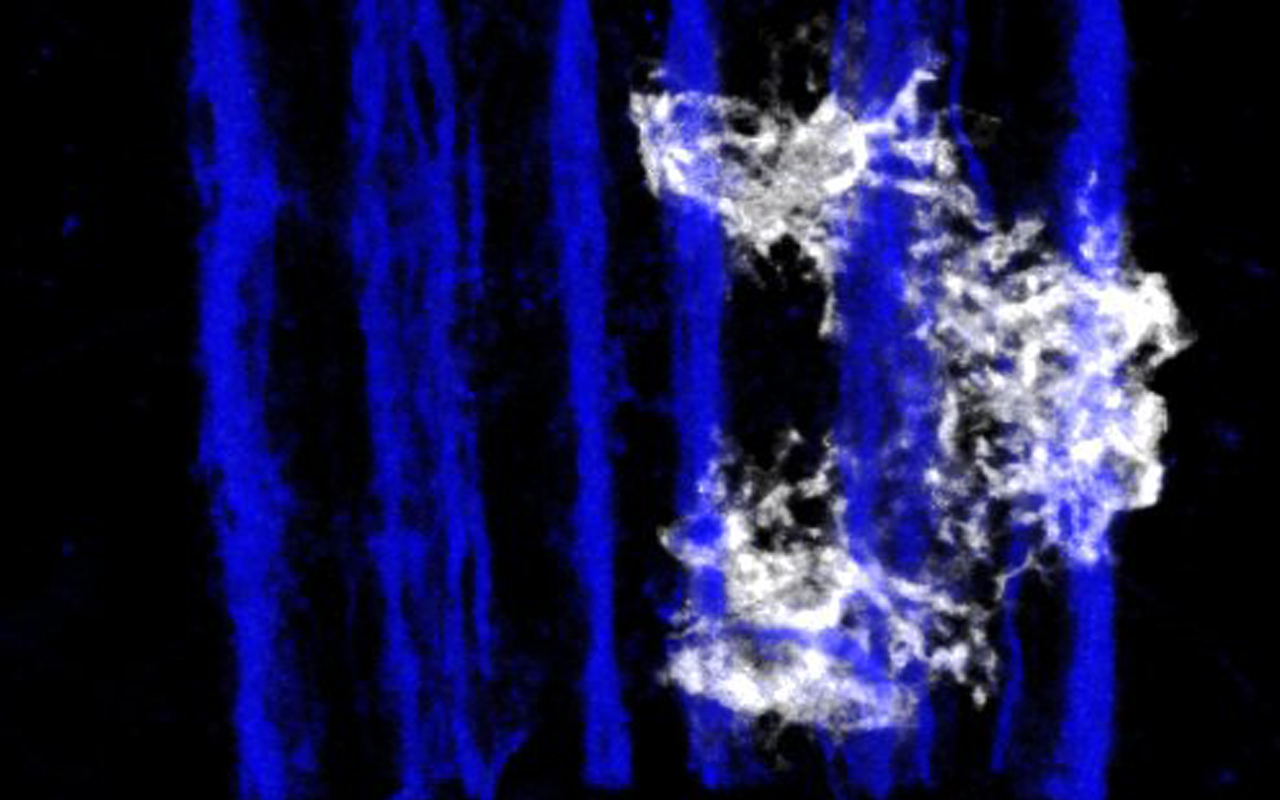
Photo by Émilie Peco
Territorial integrity
Here we are at the heart of the nervous system of a Drosophila fly larva, which functions on the same basic principles as the nervous systems of mammals, including humans. To the right are three pairs of astrocytes (white) delicately wrapped around longitudinal neuronal pathways (blue). Other astrocytes are present, but were not revealed by the marker used to capture this image. These glial cells, with their complex ramifications, are essential to the functioning of the central nervous system, but many of their roles have yet to be discovered. It is clear, however, that astrocytes are not distributed at random: they always cover the same neural areas. Scientists are still trying to understand the mechanisms that show them the way.
Jury Prize
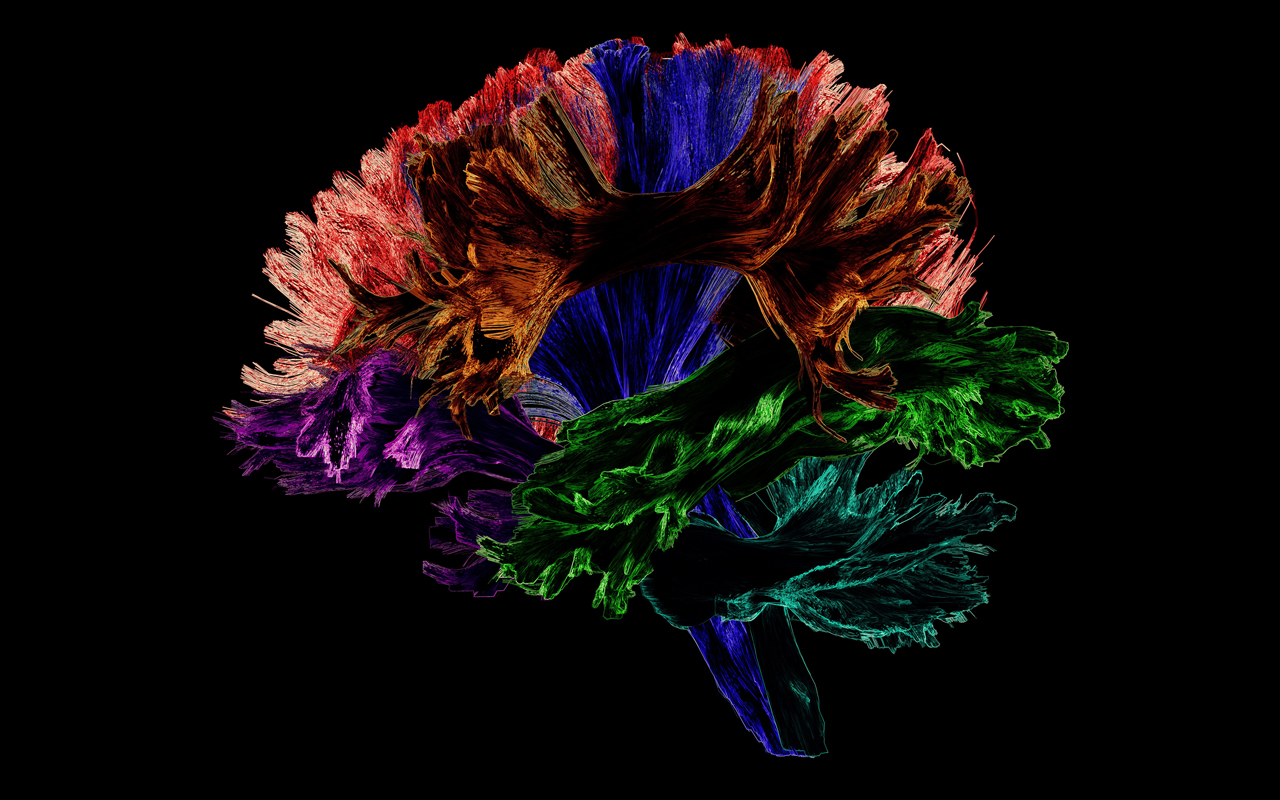
Photo by François Rheault
White matter in living colour
We all have some vague idea of what grey matter is: the tissue at the surface of the brain, with its familiar folds. But we are less familiar with the white matter that lies beneath. This white matter consists of a multitude of networks of axons, which are extensions of the neurons and constitute the brain’s “wiring”. These axons are sheathed in myelin, a white substance that facilitates the transmission of electrochemical information. The organization of these networks of axons is the same in all brains, though each has its distinctive traits. Using medical imaging technology and powerful software, scientists can now dissect a brain virtually, so that only its main neural highways remain.
People’s Choice Award

Photo by Jill Brooks
Tracking endangered sharks
Great hammerhead sharks are among the most endangered species, driven largely by Asian demand for shark fin soup and accidental bycatch from commercial fishing. Global conservation efforts are underway but they rely on knowing where these fish travel, which habitats they prefer, and how often they leave sanctuaries and swim into commercial fishing zones. In this picture, Carleton University MSc student Jill Brooks is free-diving to shoot a dart tag into the back of a shark—one of 32 tagged with an acoustic transmitter to track their movements throughout the Bahamas and the southeast coast of the United States. Data from the transmitters are sent to multiple receivers anchored to the ocean floor and shared with organizations around the world, including Canada's Ocean Tracking Network.

Photo by Daniel MacPhee
Making pregnancies safer
How uterine contractions during pregnancy and labour are controlled is still poorly understood. Yet, unravelling this mystery is vital if we hope to understand conditions such as preterm labour, which affects 5-10% of human pregnancies in North America and is responsible for 75-85% of neonatal deaths and morbidity. Problems during labour and birth also exist in large domestic animals with similar consequences. In this image of a labouring rat uterus, researchers used a high-intensity fluorescence microscope to illuminate a stream of uterine smooth muscle cells containing high levels of small heat shock protein B5. During labour, these "molecular chaperones" help produce muscle that generates coordinated and powerful contractions to ensure the timely delivery of a term fetus. This basic research could one day help physicians and veterinarians predict when labour processes could become abnormal—and in the process help protect the health and lives of both newborns and mothers.

Photo by Timothy Gibson
Early life in ancient oceans
Nunavut is home to the billion year-old, Angmaat geologic formation. Now exposed high on the coasts of Baffin Island, this ruggedly eroded rock layer once accumulated on the floor of ancient seas. These 500 metres of ancient marine sediment can be studied with the latest geochemical techniques to learn about changes in ocean chemistry, the formation of the vanished supercontinent Rodinia and new clues to the pace of evolution of very early life. New geological dating for these rocks has revealed that the first known sexually producing organism—a primitive multicellular red alga called Bangiomorpha pubescens —emerged nearly 200 million years later than previously thought and may be related to important changes in Earth's environment. The Precambrian Research Office and Publican Society at McGill University are conducting ongoing investigations of the Canadian Arctic's rich endowment of ancient rock to reveal Earth's past climates and environments.

Photo by Émilie Bouchard
Tracking parasites in Nunavut
Toxoplasma gondii is a parasite that infects warm-blooded animals, including birds and mammals. In most cases, the infection causes few symptoms but can lead to neurological, ocular, and reproductive problems, especially if the immune system is compromised or if a mammal contracts the parasite while pregnant. Humans can also become infected through contact with soil contaminated by the feces of cats or through eating infected meat. Unexpectedly, the bug is appearing in Arctic fox in Nunavut, where the main carriers, domestic and wild cats, are practically non-existent. Researchers are collecting and testing blood samples from live-trapped adult and juvenile Arctic foxes to determine if the parasite is transmitted from mom to baby via the placenta. This research will provide important information about the health effects in wildlife and how Arctic people become exposed.

Photo by Phil Angel
Butterflies feel the heat
Climate change threatens biodiversity, forcing species to move to new areas and others to disappear from the hottest areas. Butterfly biology depends strongly on temperature, and can act as a proverbial "canary in the coal mine", providing an early warning signal for climate change impacts on other species. Butterflies, and other pollinators (e.g. bumblebees) provide irreplaceable ecosystem services in agricultural landscapes and natural ecosystems. At the University of Ottawa, macroecologists have worked to collect huge numbers of butterfly observations, building on biodiversity baseline data from over a century of climate and habitat changes. Long-term data such as this have been used to demonstrate rapid pollinator declines in many parts of Canada. Pictured here is the Viceroy butterfly (Limenitis archippus), famous for its mimetic relationship with the Monarch butterfly (Danaus plexippus), and captured during sampling at a field site near Ottawa.
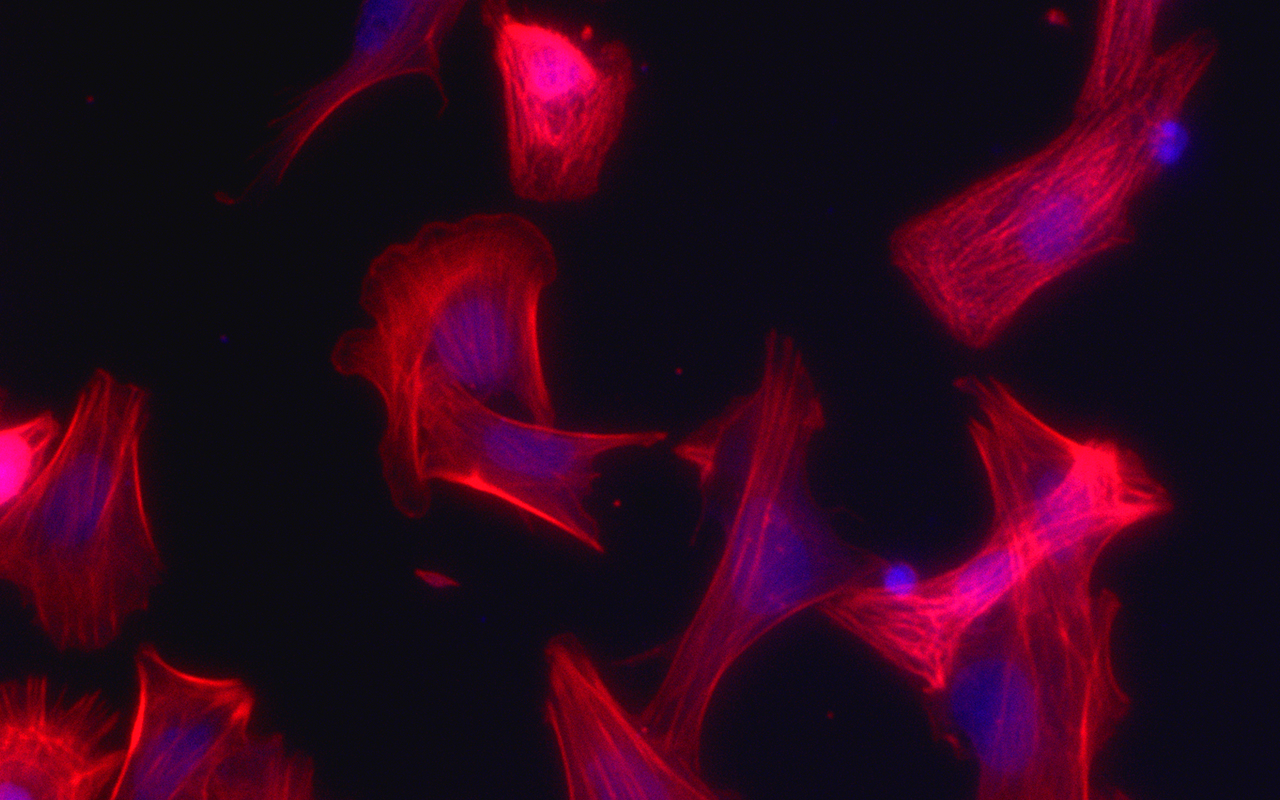
Photo by Mais Aljunaidy
Healthy fetus, healthy heart
What happens in the womb can have a powerful impact on a person's future health. Some 20% of pregnancies are affected by complications such as pre-eclampsia or poor fetal growth (e.g. low birth weight) that increase the chances of developing cardiovascular disease in adult life. However, the mechanisms underlying these changes are not known. Researchers at the University of Alberta are studying how harmful compounds released by the placenta during complicated pregnancies can cause the mother's blood vessels to no longer work properly, leading to increased blood pressure and altering the cardiovascular development of her offspring. This image shows the most prevalent cells in the heart—cardiomyocytes and fibroblast cells—forming the cardiac wall in fetal rats.

Photo by Wenge Jiang and Marc D. McKee
Inspired by nature
Nature inspires and instructs us to rationally design and build novel biomaterials that are useful to humankind. At McGill University, researchers are growing hierarchically organized biomaterials with spiralling suprastructures resembling those found in nature, including in snail shells and seashells, and in pathological "ear rocks" (otoconia), occurring in disease of the human inner ear. Working initially at the nanoscale, the team created complex handed (chiral), spiralling structures made of calcium carbonate mineral—the building block for the skeletons and shells of many marine and terrestrial organisms. To do this, they added a chiral acidic amino acid (glutamic acid). This photo shows six distinct interlacing coiled calcium carbonate platelet domains assembled into left-handed clockwise spiralling suprastructure arising from an unstructured centre core area (pink). The findings provide valuable insight into normal biomineralization processes, pathological biomineralization involving otoconia, and novel synthesis methods for next-generation materials.

Photo by Rebecca Hay
Seeing red in a cirrhotic liver
Chronic stress can contribute to multiple health problems, including depression, weight gain, and heart and liver disease. Researchers at Carleton University are studying how stress interacts with the gut hormone ghrelin to affect our health. Ghrelin—dubbed the "hunger hormone"—helps manage stress, weight gain and appetite. In this image, a liver was treated with the stress hormone corticosterone. The red represents fat deposits and the pink/blue wave through the image is scar tissue. The pattern of the scar tissue indicates a cirrhotic liver in the end stages of liver disease. This research found liver damage was most extensive in situations of both chronic stress and the absence of ghrelin signalling. The findings may have significant research and clinical implications related to obesity, diabetes and other chronic diseases.

Photo by Anastassia Voronova
Seeing inside brains
The brain is a complex network of cells that forms during pregnancy as the embryo grows into a fully formed baby. To develop properly, the brain needs stem cells, including one type called cortical precursor cells. Found in the cortex—arguably one of the most important parts of the human brain as it is involved in highly complex processes like thought, memory, perception and action —these cells contain the intricate instructions necessary to produce a healthy functioning brain. These cells go through a process called differentiation in which they become one of three "neuronal" cell types. This image of a healthy, newborn, mouse brain shows all the cells arising from cortical precursors. We can track these cells because they contain a gene that produces a red-glowing protein. By comparing this healthy specimen with other brains, we can examine the effect of external factors on brain development and the link to disorders such as autism spectrum disorder and microcephaly.
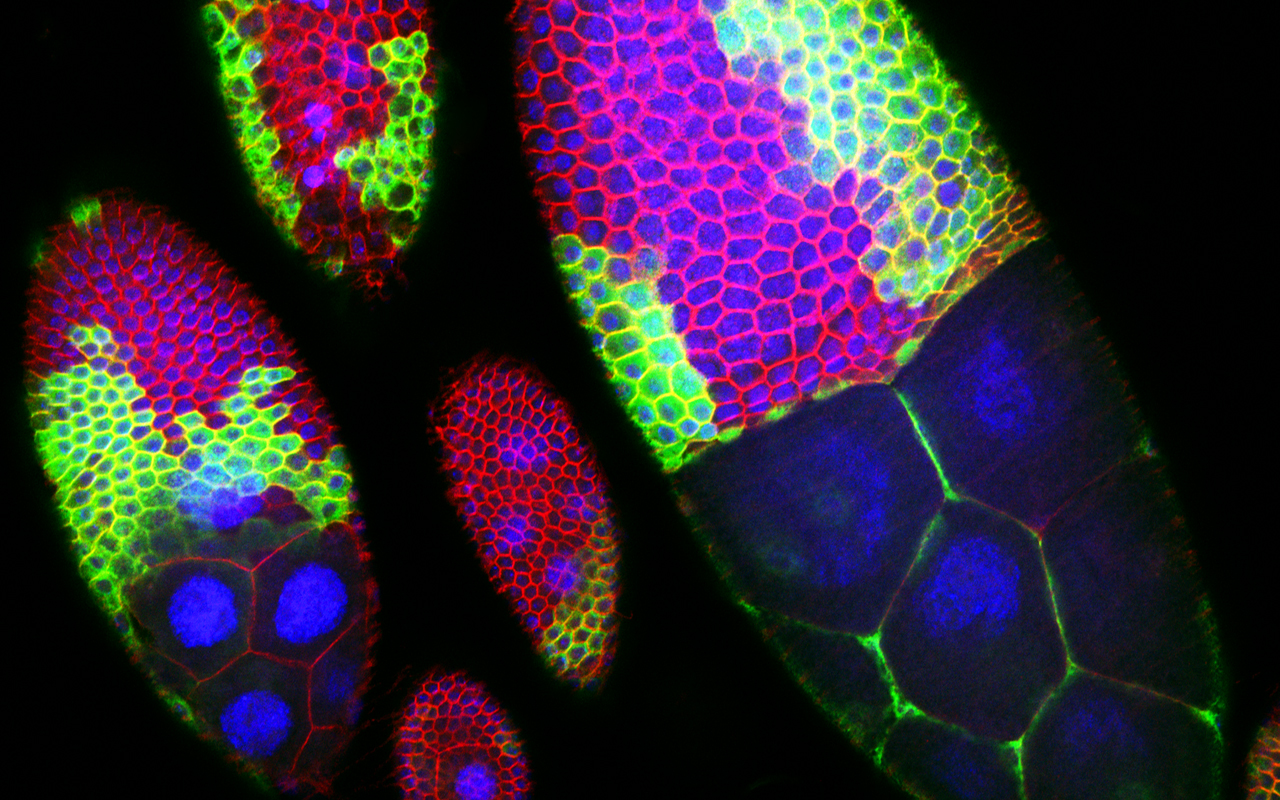
Photo by Ashley Chin
Honeycombs in fruit fly ovaries
Honeycomb patterns exist everywhere in nature, from bee hives to turtle shells. But did you know they can also be found inside the ovaries of the common fruit fly, Drosophila melanogaster? These unwelcomed household pests surprisingly share 75 percent of the genes that cause human diseases, making them an invaluable organism in biological research. This image shows developing ovaries that have been genetically modified to study cell polarity. The loss of this structural property is often a precondition and hallmark of cancer. In this image, a green dye was used to label the regions where a particular polarity gene, exhibiting honeycomb pattern, has been deactivated. This side-by-side comparison to the normal red regions is useful for identifying a gene that may be involved in controlling cell polarity, crucial knowledge for unraveling the origins of cancer.

Photo by Melanie Clapham
Let's play!
Seeing these two young subadult brown bears play fighting in Knight Inlet, BC was an unexpected sight. Such play is common among bears of the same family, but has rarely been recorded between non-littermates. In this picture, the older bear on the right is uncharacteristically taking a submissive role, as indicated by his puckered-lip and ear positioning. The younger male attempts to dominate the older bear, displaying partially-flattened ears and an open mouth with wide eyes. This University of Victoria/Brown Bear Research Network-led research on social play in brown bears forms part of a larger study on their social behaviour. The research challenges our current perception of bear behaviour, with important implications for bear conservation and public understanding.

Photo by Sara Al-Habyan
Mosaic cancer
Breast cancer lethality is often caused by cancer cells colonizing distant body parts, such as the bones, lung and liver, to name a few. To limit disease progression and develop novel therapeutic targets for cancer patients, it is vital to study how cancer cells migrate from the organ of origin to other organs. At McGill University, researchers colored cancer cells with different fluorescent dyes, including red, blue and yellow. This allows visual tracking of cells in action, and how exactly they reach distant organs. Here, a mixture of these cells is plated on a glass surface with nuclei colored in grey.

Photo by Daryan Chitsaz
The language of neurons and muscles
Amyotrophic lateral sclerosis (ALS) and multiple sclerosis (MS) are neurodegenerative diseases that attack the body's nerves, which connect to muscles. Researchers are working at the human embryonic stage to discover how hair-like nerve fibers, called axons, extend from the spinal cord to muscles throughout the body. They hope to understand how neurons and muscles communicate to support and guide each other's development, and promote nerve regeneration. This image shows a sheet of hundreds of red-labelled rat muscle precursor cells (young cells that mature into muscle cells) with a dense cluster of spinal motor neurons in green. The nuclei are stained blue. After just one day, the axons were stimulated to grow hundreds of times their original length and follow the contours of the muscle cells. The research is an important step to one day developing treatments for people who have suffered nerve injury or neurodegenerative diseases.




